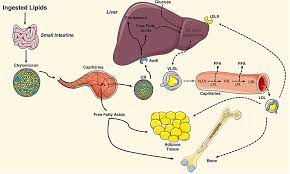Lipid metabolism is the synthesis and degradation of lipids in cells, involving the breakdown or storage of fats for energy and the synthesis of structural and functional lipids, such as those involved in the construction of cell membranes. In animals, these fats are obtained from food or are synthesized by the liver.
VOCABULARY: Lipid, synthesis, degredation, breakdown, storage, structural, cell membranes, liver
DOWNLOAD pdf: LIPID METABOLISM
The principal storage form of fat (lipid) in the body is triacylglycerol, most of which is located in white adipose tissue. Triacylglycerol stores are also found in liver and muscle and as lipoproteins in blood. Triacylglycerols are formed by the sequential linking of three free fatty acid (FFA) molecules to glycerol.
VOCABULARY: triacyglycerol, adipose tissue, lipoproteins, sequential, linking, glycerol
The synthesis of FFAs from acetyl CoA requires energy (in the form of ATP) and occurs in the cytoplasm of the cells of the liver and adipose tissue. Body tissues and organs cannot oxidize triacylglycerols directly. The triacylglycerol molecules must first be broken down into its FFA and glycerol components (lipolysis). The latter is catalyzed by a hormone-sensitive lipase found in adipocytes and muscle fibres.
VOCABULARY: acetyl, ATP, cytoplasm, oxidize, broken down, FFA, lipolysis, catalyzed, hormone-sensitive, lipase, adipocytes, fibres
Lipoprotein lipase in the capillary endothelium breaks down triacylglycerols in plasma. The principal sources of fat fuels for exercise are blood-borne FFAs derived from adipose tissue and intramuscular triacylglycerol. FFAs undergo beta-oxidation in the mitochondria, yielding acetyl CoA and reduced nicotinamide and flavin coenzymes. Acetyl CoA can enter the tricarboxylic acid cycle and the reduced coenzymes pass their electrons and hydrogen to oxygen via the mitochondrial respiratory chain. Hence, utilization of fat as an energy source requires oxygen.
VOCABULARY: capillary, fat fuels, blood-borne, intramuscular, undergo, oxidation, mitochondria, derived, beta-oxidation, yielding, acid-cycle, coenzymes, electrons, hydrogen, respiritory chain, utilisation
The rate of FFA oxidation in exercising muscle is related to the concentration of FFA in plasma and blood flow, and is also regulated in part by the oxidative capacity of the recruited muscle fibres and the availability of carbohydrate stores.
VOCABULARY: rate, concentration, plasma, blood flow, capacity, recruited

